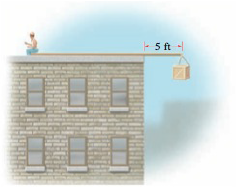
Concept explainers
Law of the Lever A plank 30 ft long rests on top of a flat-roofed building, with 5 ft of the plank projecting over the edge, as shown in the figure. A worker weighing 240 lb sits on one end of the plank. What is the largest weight that can be hung on the projecting end of the plank if it is to remain in balance? (Use the law of the lever stated in Exercise 77.)

To find: The largest weight required to balance the plank.
Answer to Problem 76E
The largest weight required to balance the plank is 1200 lb.
Explanation of Solution
Given:
The length of plank is 30 ft with 5 ft of the plank projection over the edge.
The weight of worker is 240 lb sits at the end of the plank.
Formula used: Law of the lever
The product of the weight and its distance from the fulcrum must be same on each side,
Calculation:
Let the largest weight required to balance the plank be x.
Tabulate the given information into the language of algebra.
| In words | In algebra |
| Required weight | x |
| Product of weight and distance | 5x |
Model the equation for the above information.
Simplify the above equation for x.
Thus, the largest weight required to balance the plank is 1200 lb.
Chapter 1 Solutions
Precalculus: Mathematics for Calculus - 6th Edition
- 4. Some psychologists contend that the number of facts of a certain type that are remembered after t hours is given by f(t)== 90t 951-90 Find the rate at which the number of facts remembered is changing after 1 hour and after 10 hours. Interpret.arrow_forward12:05 MA S 58 58. If f(x) = ci.metaproxy.org 25 2xon [0, 10] and n is a positive integer, then there is some Riemann sum Sthat equals the exact area under the graph of ƒ from x = Oto x = 10. 59. If the area under the graph of fon [a, b] is equal to both the left sum L, and the right sum Rfor some positive integer n, then fis constant on [a, b]. 60. If ƒ is a decreasing function on [a, b], then the area under the graph of fis greater than the left sum Land less than the right sum R₂, for any positive integer n. Problems 61 and 62 refer to the following figure showing two parcels of land along a river: River Parcel 2 Parcel 1 h(x) 500 ft 1,000 ft. Figure for 61 and 62 61. You want to purchase both parcels of land shown in the figure and make a quick check on their combined area. There is no equation for the river frontage, so you use the average of the left and right sums of rectangles covering the area. The 1,000-foot baseline is divided into 10 equal parts. At the end of each…arrow_forwardIf a snowball melts so that its surface area decreases at a rate of 10 cm²/min, find the rate (in cm/min) at which the diameter decreases when the diameter is 12 cm. (Round your answer to three decimal places.) cm/minarrow_forward
- 1) let X: N R be a sequence and let Y: N+R be the squence obtained from x by di scarding the first meN terms of x in other words Y(n) = x(m+h) then X converges to L If and only is y converges to L- 11) let Xn = cos(n) where nyo prove D2-1 that lim xn = 0 by def. h→00 ii) prove that for any irrational numbers ther exsist asquence of rational numbers (xn) converg to S.arrow_forward4.2 Product and Quotient Rules 1. 9(x)=125+1 y14+2 Use the product and/or quotient rule to find the derivative of each function. a. g(x)= b. y (2x-3)(x-1) c. y== 3x-4 √xarrow_forward4.2 Product and Quotient Rules 1. Use the product and/or quotient rule to find the derivative of each function. 2.5 a. g(x)=+1 y14+2 √x-1) b. y=(2x-3)(x-:arrow_forward
- 3. The total profit (in dollars) from selling x watches is P(x)=0.52x²-0.0002x². Find and interpret the following. a) P(100) b) P'(100)arrow_forward3. Find the slope and the equation of the tangent line to the graph of the given function at the given value of x. -4 f(x)=x-x³;x=2arrow_forward2. Find the equation of the tangent line to the graph of the given function at the given point. f(x)=(x+3)(2x²-6) at (1,-16)arrow_forward
- 6. Researchers who have been studying the alarming rate at which the level of the Dead Sea has been dropping have shown that the density d (x) (in g per cm³) of the Dead Sea brine during evaporation can be estimated by the function d(x)=1.66 0.90x+0.47x², where x is the fraction of the remaining brine, 0≤x≤1. a) Estimate the density of the brine when 60% of the brine remains. b) Find and interpret the instantaneous rate of change of the density when 60% of the brine remains.arrow_forward5. If g'(5) 10 and h'(5)=-4, find f'(5) for f(x)=4g(x)-2h(x)+3.arrow_forward2. Find each derivative. Write answers with positive exponents. a) Dx 9x -3 [97] b) f'(3) if f(x) = x²-5x² 8arrow_forward
 Calculus: Early TranscendentalsCalculusISBN:9781285741550Author:James StewartPublisher:Cengage Learning
Calculus: Early TranscendentalsCalculusISBN:9781285741550Author:James StewartPublisher:Cengage Learning Thomas' Calculus (14th Edition)CalculusISBN:9780134438986Author:Joel R. Hass, Christopher E. Heil, Maurice D. WeirPublisher:PEARSON
Thomas' Calculus (14th Edition)CalculusISBN:9780134438986Author:Joel R. Hass, Christopher E. Heil, Maurice D. WeirPublisher:PEARSON Calculus: Early Transcendentals (3rd Edition)CalculusISBN:9780134763644Author:William L. Briggs, Lyle Cochran, Bernard Gillett, Eric SchulzPublisher:PEARSON
Calculus: Early Transcendentals (3rd Edition)CalculusISBN:9780134763644Author:William L. Briggs, Lyle Cochran, Bernard Gillett, Eric SchulzPublisher:PEARSON Calculus: Early TranscendentalsCalculusISBN:9781319050740Author:Jon Rogawski, Colin Adams, Robert FranzosaPublisher:W. H. Freeman
Calculus: Early TranscendentalsCalculusISBN:9781319050740Author:Jon Rogawski, Colin Adams, Robert FranzosaPublisher:W. H. Freeman
 Calculus: Early Transcendental FunctionsCalculusISBN:9781337552516Author:Ron Larson, Bruce H. EdwardsPublisher:Cengage Learning
Calculus: Early Transcendental FunctionsCalculusISBN:9781337552516Author:Ron Larson, Bruce H. EdwardsPublisher:Cengage Learning





